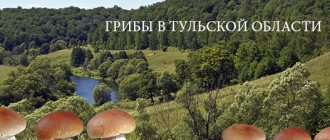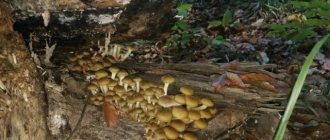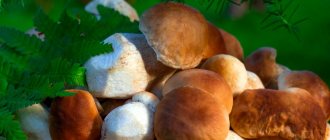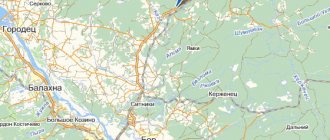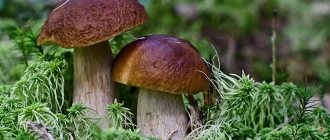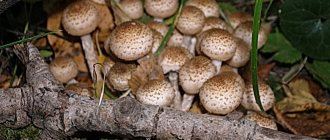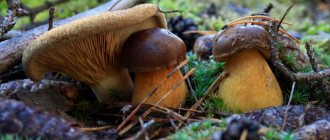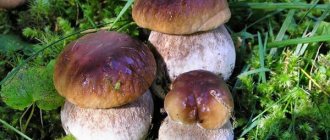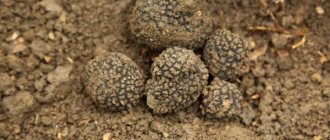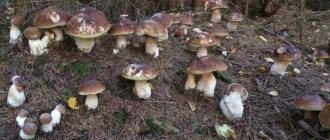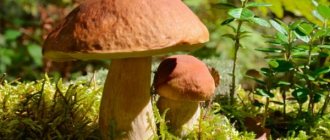Perhaps no one will refuse an exciting walk through a real forest in search of aromatic and tasty mushrooms, because this is several pleasures at once: enjoying the beauty of mixed and coniferous forests; breathe in the aroma of fallen leaves or tart pine needles; experience delight and some excitement from your “prey” and, finally, bring home a basket full of good mushrooms. By the way, it is the Tula region that can be proud of the presence of the most popular and beloved mushrooms, so it’s definitely worth visiting the local forests.
What types of mushrooms can be found in the Tula region
Among the edible mushrooms growing in the Tula region, boletuses (ceps), aspen boletuses, boletus mushrooms, boletuses, milk mushrooms, saffron milk caps, boletus, chanterelles, honey mushrooms, etc. are well known. Mushrooms in the Tula region have their own preferences in terms of collaboration with certain plants. That is why mushroom pickers know in which forests they can be found. The reserves of edible mushrooms in the region are so large that they are difficult to estimate. Almost all types of mushrooms traditionally collected in the Russian Federation can be found here.
Quiet hunting seasons
You can go hunting as early as April and end in late autumn.
| Months by year. | Types of mushrooms. |
| April: | May, lines, morels. |
| May: | oyster mushrooms, May mushrooms, honey mushrooms, boletus mushrooms, morels, russula. |
| June: | oyster mushrooms, puffballs, chanterelles, May mushrooms, honey mushrooms, boletuses, aspen mushrooms, russula. |
| July: | white, oyster mushrooms, milk mushrooms, bitter mushrooms, goat mushrooms, chanterelles, boletus, honey mushrooms, boletus mushrooms, boletus mushrooms, saffron milk caps, silver mushrooms, violin mushrooms. |
| August: | white mushrooms, oyster mushrooms, milk mushrooms, goat mushrooms, fly mushrooms, boletus mushrooms, honey mushrooms, autumn mushrooms, boletus mushrooms, aspen mushrooms, row mushrooms, russula mushrooms, champignons. |
| September: | the same as in August. |
| October: | white mushrooms, oyster mushrooms, moss mushrooms, honey mushrooms, boletus mushrooms, row mushrooms, white mushrooms. |
| November: | oyster mushroom, goat, autumn and winter honey mushrooms, row. |
The main thing is to know where to look
The region's wooded area, including planted forests, makes up approximately 14% of the entire territory. Coniferous forests (pine, larch, spruce) account for more than 13% of the area of the local green fund. And mushroom places in the Tula region are located mostly in the north and northwest. Among large and small-leaved species, oak, birch, linden, and aspen predominate. On the southern border with the forest-steppe there are oak-ash forests, in which you can also find elm or maple.
So when and where is the best time to pick mushrooms, and what places are most favorable for this? Firstly, you need to go after the recent rain. Secondly, towards the forest and away from people.
The best mushroom areas of the Tula region
The wooded part of the Odoevsky district, once impassable, is famous for its abundant mushroom harvests, therefore, while in this area, it is definitely worth devoting an hour or two to “quiet hunting”.
The most environmentally friendly local mushrooms are considered to be those growing in the Suvorovsky, Belevsky and Arsenyevsky districts. Chanterelles, boletus, boletus, and saffron milk caps will replenish the collected collection of mushrooms. But you can’t offend the Leninsky district closest to Tula, as well as Yasnogorsky, Chersky, Efremovsky, where you can easily collect the best mushrooms in the region, and more than one basket. Here you will find boletus, boletus, boletus and many other species.
In places where mushrooms grow abundantly, there should be a lot of heat and moisture. Mushroom pickers will delight in the unique mixed forests of the Dubensky and Odoevsky districts and the Aleksinsky pine forests. In addition to boletus, boletus, saffron milk caps and chanterelles, here you can simultaneously harvest a good harvest of hazelnuts, rose hips, strawberries and even raspberries. In general, the Tula region is truly rich in summer-autumn natural gifts. And mushroom places in the Tula region are spread out literally everywhere.
Precautionary measures
If you go on a “silent hunt”, you should know some safety rules.
Take a book with you that will list all the local mushroom spots and descriptions of the varieties. This will make it easier to decide whether you have found a poisonous or edible specimen.
Although the Tula region is not included in the list of the most mushroom places in Russia, this is not a reason to be sad! Local residents, having visited the forest at least several times in 2019, appreciated its gifts, collecting valuable species in their baskets, differing in their taste, aroma and even size. And if our readers have not yet had time to enjoy the gifts of nature, it’s time to go on a quiet hunt to assess the current year’s yield by comparing last year’s fruits with today’s.
Important!
You can get to Aleksinsky, Venevsky or Leninsky district not only by bus and taxi, but also by private car. It is enough to turn on the navigator to get to the desired point in a short time.
Mushroom Seasons
Almost all lovers know that mushrooms in the Tula region grow seasonally, that is, each species has its own specific time. Mushrooms in Tula mixed and coniferous forests appear in waves, depending on weather conditions. It is thanks to this that during the summer-autumn season you can get on 3-4 alternating waves.
And although in this rich natural region you can pick mushrooms as early as June, September is still considered the main mushroom month. Even during the season of warm autumn rains, mushroom places in the Tula region will give each collector two buckets of excellent specimens.
Map of mushroom places
It is impossible to show specific places in the Tula region, and it would be stupid to do so. As soon as information is received that there are many mushrooms in such and such a forest, hundreds of pickers rush there, mercilessly cut off the mycelium, and then it is almost impossible to find anything in this place, even for several years.
However, there are guidelines for assembly. The main gathering places are the northern part. In the south, in forest belts you can also find mushrooms, but mostly puffballs, sometimes morels.
Finding a suitable forest is quite easy - look at the satellite for the most remote area, and off you go. Near cities it is extremely difficult to find anything.
Prilepy, Mordves, Yasnogorsk, Dyadilovskie settlements, Aleksandrovka, Botnya, Senevo, Tarusa, Strakhovo are the most popular destinations for “silent hunting”.
The ideal option for a trip is, of course, a car or a bicycle, but you can always get there by public transport, bus or train.
Mushrooms in June
After the earth warms up a little from the sun's rays, the first mushrooms - morels - begin to appear. And although they are considered edible only after special processing, there are those who like to try morel dishes. But according to popular belief, in the very places where this mushroom was collected, boletus mushrooms will come next.
On damp stumps and logs of deciduous trees you can find a cheerful company of honey mushrooms or colorful russula. All June mushrooms are usually called spikelets, since they appear during the heading of rye.
July mushrooms of Tula forests
The second summer month is rich in russula and honey mushrooms, which grow in any forest - both deciduous and coniferous. Not far from the birch forests you can collect young and strong trees, and in the pine groves after the rains you can pick up boletus.
Under the small-leaved trees, through which sufficient solar heat and light penetrates, boletus and boletus grow, and towards the end of the month even noble boletus and aspen boletuses grow. In deciduous forests, mushroom pickers will get hold of delicious mushrooms and mushrooms.
In birch and mixed forests you can find a very cute and tasty mushroom, which is admired by many. When properly processed, white or pink mushroom has a very pleasant taste, and looking for it in the forest is a pleasure, since the mushroom is quite large and grows in families.
But real lovers are waiting for porcini mushrooms.
Differences between the false chanterelle
Having a similar appearance at first glance, the false chanterelle has a number of differences from the real one:
- has an intense color, bright yellow or bright orange. Edible has colors that are not so saturated;
- The hat has an ideal geometric shape. The real one has irregular edges;
- the stem is thin, lighter than the cap and hollow inside. The ordinary one has a stem of the same color as the cap, dense in structure;
- has an unpleasant odor, but this one has a pleasant mushroom aroma;
- grows on fallen trees or stumps. The common one grows only on the ground;
- they always grow up alone, while real ones grow up in families;
- the pulp is uniformly bright yellow or orange, and the ordinary pulp is light yellow with a white center.
Video: How to distinguish a false chanterelle from a real one
August mushrooms of Tula forests and oak forests
August is already the beginning of the real season. Thus, seasonal mushrooms in the Tula region in 2014 were very diverse, and the harvest was rich in saffron milk caps, chanterelles, boletus mushrooms, moss mushrooms and boletus mushrooms.
The beautiful yellow fox is not only tasty, but also rich in carotene, which makes it valuable as a dietary product. She loves places sprinkled with pine needles and wrapped in moss. It grows in small groups but is incredibly productive.
Everyone's favorite porcini mushrooms and boletus are actively growing out of the ground. The porcini mushroom (boletus) is rightfully considered royal. It has incredible taste, aroma and low calorie content. Depending on the growing conditions and age, it may have a light or dark brown cap. Prefers both pine forests and mixed forests. Under good conditions, the height of its stem can reach 30 centimeters, and the diameter of the cap – 50 centimeters!
The description of mushrooms can go on indefinitely. In general, this is the main month of mushroom picking in the Tula region, when people try to stock up on their favorite species for the winter. They are dried, salted and pickled so that they can enjoy preparing aromatic, healthy and tasty dishes for many months.
Mushroom places + map in photo
To go in search of your share of the mushroom harvest, you just need to listen to the real reviews of mushroom pickers, who left their opinions every day on city forums and social networks. There they boast not only of their achievements and the size of each catch from a quiet hunt, but also talk about their favorite places, comparing them by yield and varieties of edible mycelium covering the forest area.
Aleksinsky district
The northwestern part of the Tula region is rich in noble mushrooms that differ in the time of growth. From the beginning of spring to the end of autumn in the Aleksinsky district you can find obabka, Polish and porcini mushrooms, various milk mushrooms and even honey mushrooms. Most mushrooms germinate during periods of increased humidity, after rains and windy weather.
- Obabki
Boletuses and boletuses germinate in the Aleksinsky district more often than any others. They can be found in young birch and aspen trees. The main distinguishing feature of obobki is their noble appearance. A dark cap of brown or reddish color, a light stalk with or without inclusions, prominent growth and good volume - allow you to see the mushroom from afar, regardless of whether it is trying to hide in foliage, grass and trees or not.
The length of the mushroom can reach 32-34 cm. The diameter of the cap is 28-36 cm. The pulp is white, and can become bluish when cut after a few minutes.
- White and Polish mushrooms
From mid-summer until the end of autumn, under favorable weather conditions, porcini and Polish mushrooms germinate in deciduous and mixed forests close to each other. They can be found in small ravines, tall grass and near water.
- Honey mushrooms
In the summer in the Aleksinsky district you can find many summer mushrooms growing on paths, meadows and even forests. In 2022, if not many of them, then plenty...
From mid-August, Assumption honey mushrooms appear, and a little later - autumn and winter specimens, covering dilapidated stumps, edges and forest paths.
- Milk mushrooms
Mushroom places in the Tula region in 2022 also pleased with the varieties of milk mushrooms. Some are prepared immediately, others require long soaking. But despite this, each of the subspecies is very tasty and deserves special attention.
Venevsky district
If you look at a map of the Tula region and consider the Venevsky district, you can find out where many mushroom pickers go on a quiet hunt every weekend. There, locals and visitors collect many valuable species, as well as spring and summer mushrooms with an average taste. We are talking about morels and strings, forest champignons, honey mushrooms and rows.
- Be careful, piggy!
If previously many people collected pig meat and consumed it in various forms, now doctors warn about its hidden harm to health. Pig contains a small percentage of poisons and toxins that can kill, if not immediately, then at any time throughout life. Therefore, before you start collecting these conditionally edible mushrooms, you should weigh all the pros and cons so that after possible problems you do not regret what you did.
- Butter
Everyone's favorite boletus is found in the coniferous forest. They grow next to young pine trees, swampy areas, tall grass and even paths that allow sunlight to pass through well.
- Morels and lines
In the spring season, you can collect many unusual mushrooms that have a cone-shaped or “flattened” cap shape. You can find them from the beginning of April until the end of spring.
Leninsky district
This area is rich in chanterelles, boletus and rowers. Although not every season, at least from summer to autumn you can find many tasty and valuable fruits rich in vitamins, microelements and minerals. You can use them to prepare a variety of dishes, winter preparations and even snacks. For example, many housewives love the recipe for a delicate pate that goes perfectly with the festive table menu.
Despite the fact that in the Leninsky district the mushrooms are not as noble as in the Venevsky and Aleksinsky districts, and are inferior in taste and aroma to many types, they can be cooked in such a way that the difference will not be noticeable. Using seasonings, spices and herbs, you can add even a subtle aroma - good taste and captivating aroma.
Mushrooms of the Tula region in 2022 will delight both local residents and guests from other regions who decide to admire the beauty of the forest landscapes and its rich harvest.
Autumn mushrooms of the Tula region
At the beginning of autumn, mushroom pickers like to collect boletus and boletus mushrooms, boletuses, boletus and milk mushrooms. During this period, collectors look for mushroom places in the Tula region where there are slopes and hillocks, illuminated by the sun most of the day.
The main autumn mushrooms are valui and chanterelles, although champignons and the honey mushroom family can be found almost before frost. Sometimes you come across milk mushrooms, bluefish and other species, but they are becoming less and less common.
In reference books you can find detailed descriptions of mushrooms with illustrations, and then beginners will definitely not go wrong in their search. Although it is best if novice mushroom pickers go on a hike with experts. There are many walking routes in the Tula region that are easily accessible by train or car. And the unique local forests are not only fertile, but also environmentally friendly, so you should definitely visit there and enjoy active recreation, clean air and return with baskets full of first-class mushrooms.
Dangerous mushrooms (cases of poisoning)
Residents of the Tula region are natural mushroom pickers; there are not many cases of mushroom poisoning. Lethal cases occur approximately 1-2 times every 5 years; once a year, 5-8 people with moderate poisoning end up in hospitals.
The cause of poisoning is a violation of the golden rule “unsure - don’t take it.”
Push floats are constantly confused with toadstools, and as a result, poisoning can be severe.
Strings and morels are also in first place among poisonings.
Purple boletus is another extremely poisonous mushroom found in the Tula region. He looks noble, he looks like white, he even has identical plates under his cap. It is distinguished by the purple tint of the hat, plus, if you cut it, it immediately darkens.
Any forum is replete with questions “what kind of mushroom is this”, “is it possible to eat it”, and often the toadstool lies in one basket with healthy mushrooms.
To avoid getting poisoned, you only need to collect what you know. Ideally, take only boletus, boletus, boletus, boletus and boletus mushrooms. That’s all. They are easy to distinguish from poisonous ones and are safe.
And, of course, you should not collect raincoats in the city, in parks, or close to roads - they contain more toxins than toadstools.
